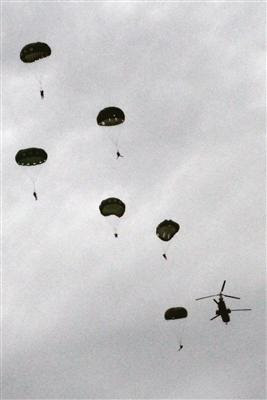
Marine Corps Bases Japan
U.S. Army paratroopers with 1st Battalion, 1st Special Forces Group Airborne, are dropped out of a Marine CH-46E Sea Knight helicopter over Ie Shima, Japan, Nov. 29. The helicopter crew supported static-line parachute operations, giving the paratroopers an opportunity to practice and train with Marine pilots. The pilots are with Marine Medium Helicopter Squadron 262, Marine Aircraft Group 36, 1st Marine Aircraft Wing.Soldiers jump sky-high with Flying Tigers
IE SHIMA, OKINAWA, Japan — Marine pilots with Marine Medium Helicopter Squadron 262 flew soldiers from the U.S. Army’s 1st Battalion, 1st Special Forces Group Airborne, as they conducted static-line parachute operations on Ie Shima Nov. 29, during Ryukyu Warrior 2012.Ryukyu Warrior 2012 is an annual Marine air command and control systems training evolution, which gives squadrons and personnel within 1st MAW, and units from other services, the opportunity to familiarize personnel with equipment, and provide new Marines an opportunity to gain experience.
The pilots with the squadron, known as the Flying Tigers, flew two CH-46E Sea Knight helicopters with 1st Battalion, 1st Special Forces Group Airborne, soldiers onboard.
In static-line parachuting, a static line, or fixed cord, is attached to one end of the aircraft while the other end is attached to the pilot chute inside the jumper’s backpack. This opens a jumper’s parachute automatically upon exiting the aircraft.
On the island of Okinawa, Marine pilots often provide air assets for the Army because the Army does not have an internal aviation element, said Marine Capt. Cory J. Jobst, a ground training officer with the squadron.
“These training exercises with other branches provide mutual benefits for each side,” said Jobst. “My Marine pilots get routine flight training and also the benefit of training with the Army paratroopers.”
Both Marine and Air Force pilots assist the Army in flight exercises on Ie Shima, said Army Staff Sgt. Kerry M. Devery, a satellite communications noncommissioned officer-in-charge with 1st Battalion, 1st Special Forces Group Airborne.
“When the Marines are flying you can feel a sense of urgency and importance in the training,” said Devery.
For training purposes, 1st Battalion, 1st Special Forces Group Airborne, uses a drop zone on Ie Shima island, where Pulitzer Prize-winning journalist Ernie Pyle died during the Battle of Okinawa.
For the safety of the paratroopers, Marine pilots communicate with special forces support personnel on the ground at the drop zone. Communication between the two is key in ensuring a safe jump, said Army Staff Sgt. Nathaniel R. Giese, a special forces medical sergeant with 1st Battalion, 1st Special Forces Group Airborne.
“Safety is our number one priority with the jumps,” said Giese. “Wind, weather and location all play a part in a successful jump.
(c) USMC














No comments:
Post a Comment